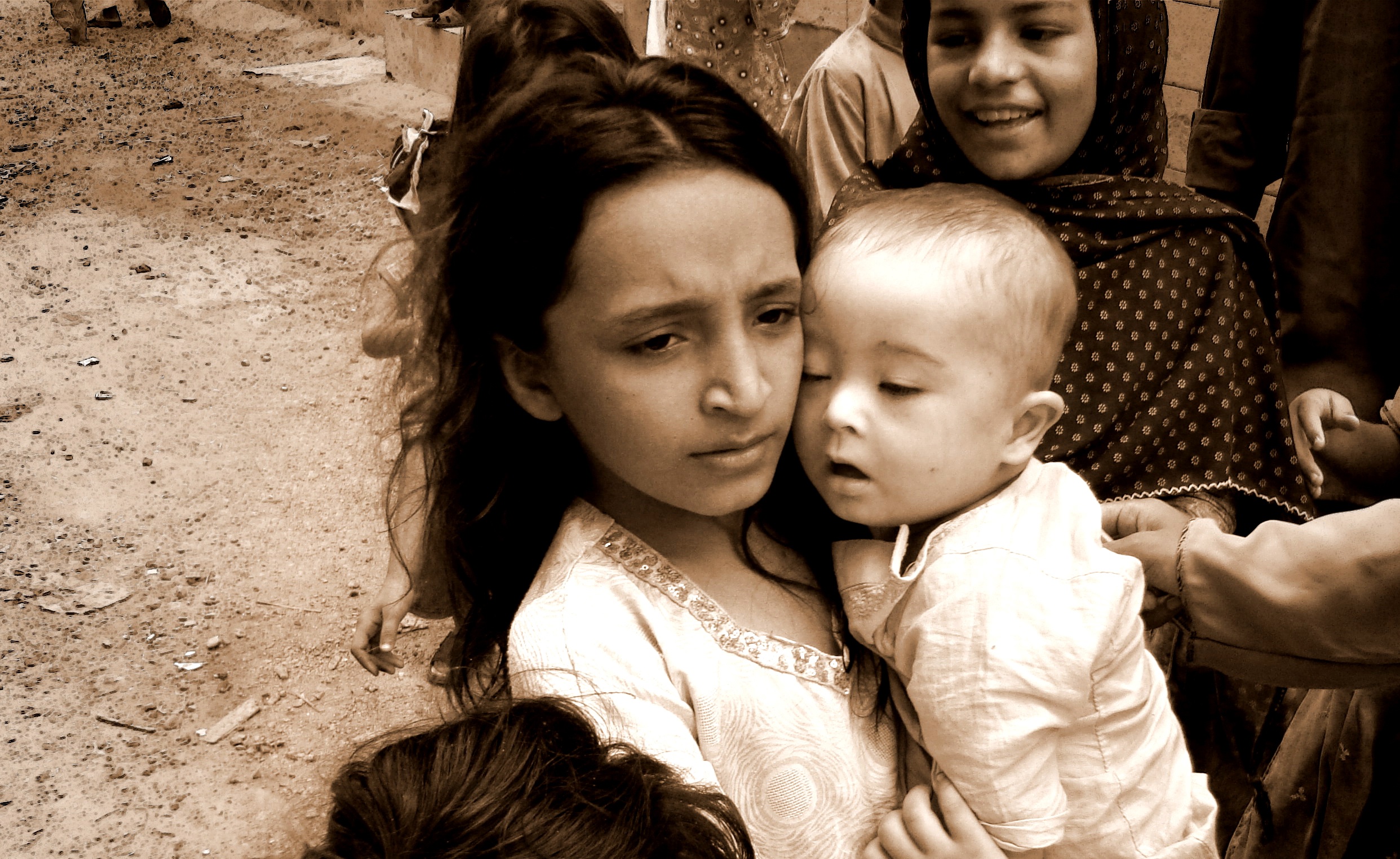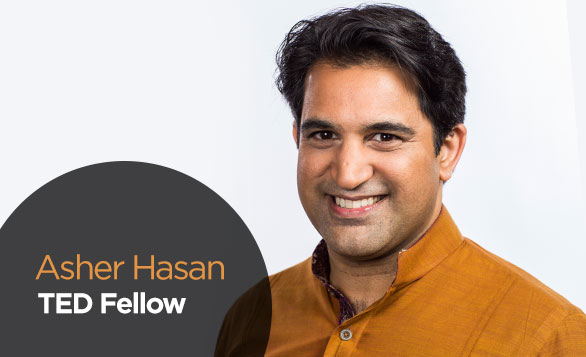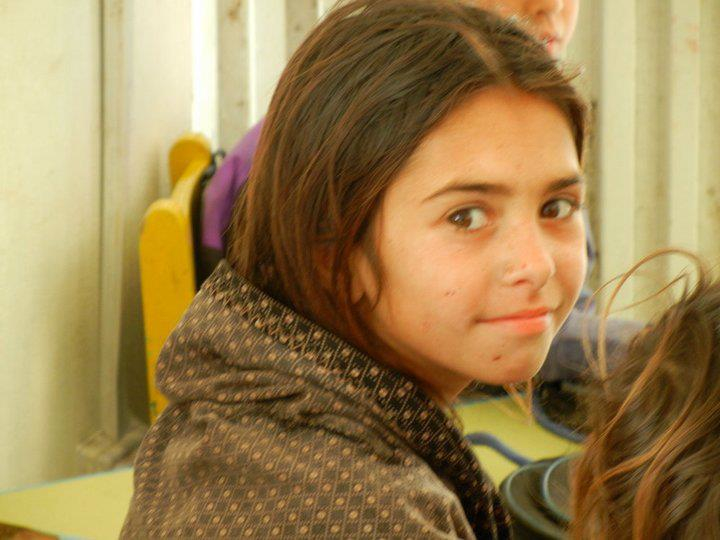Growing up in the UK and coming of age in Pakistan, TEDIndia Fellow Asher Hasan observed a vast discrepancy: those with and without access to basic healthcare, and the devastating social consequences of this disparity. He tells TED Blog the story of how he witnessed a single health disaster ruin the hopes of his childhood friends, and how this compelled him to attempt to transform a broken healthcare system with his Pakistan-based health micro-insurance company, Naya Jeevan, which offers not only quality, affordable healthcare to the urban poor, but also the financial and social inclusion the rest of us take for granted.
What does your organization do, and why?
The name Naya Jeevan traces its roots from Sanskrit, and means “new life” in modern Hindi and Urdu. We are committed to bringing low-income families in the emerging world out of poverty by providing them with affordable access to quality healthcare, financial inclusion and socio-economic opportunity. This is important because in many developing countries, catastrophic medical events trigger financial shocks that can decimate low-income families, especially as they have no public support system or safety net.
We collaborate with large, multinational corporations, and cascade our health plan up and down their value chains, essentially targeting low-income businesses and workers — mainly informal workers, domestic workers, factory workers and so on — who are either on the supply side or on the distribution/retail side. We encourage corporate executives and managers to enroll their informal domestic employees. So, for example, you could be a small-hold farmer supplying milk to a dairy company. You could be a retailer — or a micro-retailer, in some rural village — who happens to be selling a basket of products that includes products by Unilever, P&G, and so on.
For example, Unilever, which is re-launching our domestic worker plan this year, encourages its officers and managers to enroll their domestic staff — their drivers, maids and those workers’ families — in our healthcare program. The premiums are deducted from the payroll of the Unilever manager or executive. Or a corporation might directly finance the healthcare of micro-retailers who are selling their products.
The beneficiary can make co-payments, typically by mobile phone, using mobile financial services now widely available in South Asia. Enrollment in a mobile bank account will soon be part of the health plan we offer, because the people we typically serve are also unbanked. This way, they get the additional benefit of building up a financial transactional history that serves as a de facto credit report for them.
Naya Jeevan addresses socio-economic empowerment as well, tackling the informal system of what I call socio-economic apartheid in many developing countries, where there’s a rich, elitist class, and then there’s the other 90% that serves them. The rich get so used to this social dynamic that they almost start treating those who work for them like subhumans. I’ve seen many instances where even friends and family, in certain instances, have abused their domestic staff — yelled at them, beaten them, and so on. It’s absolutely disgusting, and it has to stop. Because this master-servant mindset is still pervasive, employee benefits of any type have never before been extended to these informal employees. Prior to Naya Jeevan, nobody ever considered the possibility of giving health insurance to their maid, or to their driver, or to their driver’s child, for example.
There’s a personal hook to this story…
There’s very much a personal hook to the story. My father was born in India, but some of his family members were raised in Pakistan. As a young man, he went to the UK, so I was born and raised there until I was 11, when my dad passed away from cancer. My mom, who was also born in India but raised in Pakistan, brought us back to Karachi, and I finished my schooling there.
When I first travelled to Pakistan, I was really shocked to see the tremendous disparity between rich and poor — between the elites who had unlimited access to resources and opportunity, and everybody else, who didn’t. I was especially shocked about the lack of access to healthcare in comparison to the UK, where everyone, regardless of income, has access to a national health insurance system, and where, relatively speaking, people of varying incomes have a fairly comparable quality of life.
I had direct exposure to this disparity between rich and poor. My mother had a maid with six kids, who were all within my age range, between 8 and 14. I was 11 when I first moved to Pakistan, and grew very close to these kids. Essentially, they were like my siblings. These kids were brilliant, dynamic — and I’m convinced that if they had the opportunity or had they been born in a different country, they could have become leaders of our country. They were far more intelligent than I was, that was for sure. And even though their parents — the maid and her husband, who was a mechanic — were very committed to educating them, there was a glass ceiling, a predefined trajectory that their lives seemed to be taking.
The year I left for the US for college, their father had a stroke. He’d had many, many years of uncontrolled blood pressure. Typically, in the lifestyle of low-income laborers, there’s no concept of preventive health care. It’s very much crisis management. He was taken to a public hospital, not diagnosed in time, not treated in time, and ended up paralyzed and completely incapacitated.
This had a devastating effect on the family. The kids’ mother, a very proud lady, did not want to depend indefinitely on charity, so she made the rather fateful decision to pull all six kids out of school and place them in different child labor situations. Two ended up in houses working as maids, two ended up on the street selling candy, two ended up working in apprenticeships. All six of them ended up being sexually, physically and psychologically abused.
When I returned to Pakistan during my sophomore year for a visit, I was really disturbed to see the profound impact their father’s incapacitation had on their lives. These once dynamic, bubbly kids who were full of life were completely jaded and disillusioned. It was almost like their lives had been sucked out of them and they had simply given up. Rabia, who is three years older than me, said, “You know, I’m the daughter of a maid and I’m destined to be a maid. This is my ‘kismet’ (fate). We can’t expect to be treated like royalty, or to come out of poverty.” Her father’s stroke was the first trigger event that put me on the path of doing what I do.

A child taking care of her baby brother while her mother, a domestic maid, is busy working. This is a major issue with informal workers, who don’t have access to day-care — leaving them exposed to a variety of social hazards. Photo: Naya Jeevan
What happened next?
I went to medical school in the US, spent a couple of years at Harvard Medical School and Mass General Hospital tinkering around in the research labs, and then moved on to Beth Israel for surgery residency. I then transitioned into the pharma-biotech industry, which ultimately took me to San Diego, land of the cushy lifestyle, during which time I also completed an MBA from NYU. By the summer of 2007, I had acquired scientific acumen and learned some business skills. Materially and intellectually, I guess I was quite enriched, but I felt spiritually bankrupt. I think my spirit was very restless at that time and craved something more meaningful. I got another jolt in 2005, when my mother, a diabetic for many years, also ended up having a massive stroke. She was taken to one of the best hospitals — in fact, she only lived about 10 minutes away from one of the best hospitals in the country — but she died on the way there.
My mother’s death was another powerful trigger event for me. It was like someone drilling a message into my brain: “Wake up, stupid! You have lived and witnessed socio-economic apartheid, you have accumulated all this technical expertise, you understand the healthcare system, you understand the Desi culture, you speak the language, so what are you doing about changing the system?” I had to look deep inside myself in search of an answer to that question.
I started thinking seriously about what I needed to do to change the direction of my self-centered life and to do something to tackle this issue head-on. Ultimately, if we want to get both people and developing countries out of vicious cycles of poverty and aid dependency, we need to do everything we can to create the scaffolding that will enable them to build their own way out. Given my background, I thought, “Okay, I need to come up with a healthcare model that’s sustainable, scalable, replicable, and will help to transform or catalyze the transformation of the healthcare system in Pakistan and subsequently in other emerging nations.”
I left the biotech industry, took a quantum leap of faith and and plunged full time into tackling this issue. I took a bunch of graduate students with me to Pakistan and India, and we did a fairly thorough, three-month landscape analysis of the health systems there to understand the nature of the beast. We looked at the health care systems, the stakeholders, the role of the private sector, the role of the corporations, the role of the public sector, public health systems. It was a fairly rigorous assessment of what the status quo was, what the unmet needs were. We interviewed a lot of our potential customers — low-income beneficiaries — to better understand their needs.
What did you find?
We realized, during that assessment, that there was actually a fairly robust private health insurance system in place in both countries, but only the corporate elite had access to it. So if you happened to be working for Coca-Cola, or for P&G, or for Unilever, then you were included in the system — otherwise you were excluded from it. Most people in India and Pakistan were not even aware that such a system existed. It works much like it does in the US, where you have access to a network of hospitals. You show your membership or health plan card, and you get treated. The same system was growing and developing in both India and in Pakistan. So we thought, rather than reinventing the wheel, why not just leverage this system but enhance it by adding features that would address the needs of the marginalized?
We started meeting with various health insurance companies and negotiating large group health plans. If we were to enroll 500,000 lives, what is the best price they could give us? Along the way, we realized that we needed to wrap these health insurance plans with services that also met the immediate, tangible needs of the marginalized.
What are some of those needs?
Health insurance in many developing countries tends to be catastrophic in nature — mostly hospital based. Healthcare in the primary, or outpatient setting, is typically unregulated. It’s very difficult for insurance companies to monitor or verify appropriate treatment. So they choose to mitigate their risk by just focusing on inpatient hospital-based care, which is easier to monitor and regulate. Yet the marginalized actually need greater access to primary care — primarily because of the higher-risk, more polluted environments they live and work in. The challenge for us was how to address these needs in a scalable way?
We started providing our members with 24-7 mobile phone access to family doctors, who would also have examined each patient that would help establish a baseline heath assesment to identify latent or hidden disease. After that assessment, we’d basically provide large employer groups with a group risk profile of their worker population, and recommend and deliver customized interventions, interactive preventive health workshops, or health education seminars. If we notice that there’s a group of women working in a factory who perhaps don’t know enough about breast cancer prevention, we’d conduct a workshop on breast cancer screening and self-examination given by one of our doctors.
We also recognized that a lot of poor people feel really intimidated when they walk into a gleaming private hospital with lots of sophisticated medical equipment. It’s unnerving and disorienting for them. Historically, they’ve also been discriminated against in those environments. In order to make them feel more comfortable, our family doctors also serve as liaisons, navigators and patient advocates. They will speak in advance to the hospital’s treating physician, and say, “I’m sending my patient to you; please make sure they get good, quality care.”
If we receive customer complaints or reports of substandard treatment or any kind of social discrimination, the care provider and hospital don’t get reimbursed for that care. This financial penalty creates a kind of a check and balance to make sure that our members don’t face discrimination or get pushed down the list to make way for higher-income patients. Social prejudice was a major concern when we first started enrolling our low-income members, so this is something we remain vigilant about.
Given that there has been no culture in Pakistan around helping the underserved, how did you suddenly bridge that gap?
That’s a very good question, and this is where I think generation X and Y are playing a huge, catalytic role. What we have seen is that the early adopters of our health plan for the marginalized have been younger, more globally connected entrepreneurs and corporate business people, who tend to be in their 20s and 30s, and understand the benefits of this. I have witnessed more empathy from them than generations that preceded them. The younger generations realize that it’s not only unfair, but that there’s just something intrinsically and morally wrong about this social injustice.
So the millennials and Ys have kept us in business. The good news is that the demographics are shifting rapidly in that direction. Two-thirds of Pakistan is now below the age of 25, so the demographics are increasingly in our favor. We’re optimistic that we’re close to the “tipping point” that Malcolm Gladwell refers to, and on the verge of really taking off in a big way. But it is absolutely true that health insurance for low-income workers remains a big paradigm shift for many employers — both informal employers and formal employers, as well as employers who contract in services. A lot of people circumvent the law — which they also do in the US, by the way — by hiring a contract-based workforce. If you’re a contractee, or you’re part-time, you’re not entitled to benefits. It’s exactly the same in the US.
But in Pakistan, because the cost of that benefit is so cheap (only $2 per person per month), we have been able to convince a lot of employers to enroll their part-time or contractual staff into these plans as well. A lot of corporations are doing that it. Two dollars per person per month is a drop in the ocean for many of these large companies.
How does this service directly benefit corporations?
For our corporate clients, insuring employees has proven very valuable, because there have been a multitude of cases we have screened and isolated where client-facing employees could have potentially passed on airborne infectious disease to clients, which would have been a PR fiasco. One particular company came to us as soon as one of their field representatives, who was a contract employee died in a road accident. They suddenly realized after this tragedy that they were exposing themselves to a lot of reputational risk, and that they needed to protect all of their field workers.
So sometimes it’s reactionary, but sometimes it’s also proactive. The ultimate form of asset protection is human asset protection — that’s what health insurance is. I think some companies are beginning to understand that it’s no longer sustainable for them to maximize profits in the short term at the expense of long-term externalities.
How many people do you now serve, and what is in store for future?
Currently, about 250,000 urban slum dwellers have access to our primary care plan, and an additional 68,000 members have been enrolled in our health insurance plan across 90 companies over the past four years. To achieve sustainability, we need to get to 150,000 insured lives. Those of us who are more optimistic have projected for Q2 of 2015; those who are more conservative have projected for Q2 2016. So, knock on wood — let’s see if we can make it sooner rather than later! It’s pretty ambitious, but, you know, we’re a fairly ambitious bunch of people.


Comments (8)
Pingback: Working for the health of the many | Healthy Actuary
Pingback: Working for the health of the many: How Asher Hasan is bringing insurance coverage to Pakistan’s low-income workers
Pingback: Working for the health of the many: How Asher Hasan is bringing insurance coverage to Pakistan’s low-income workers | TEDFellows Blog